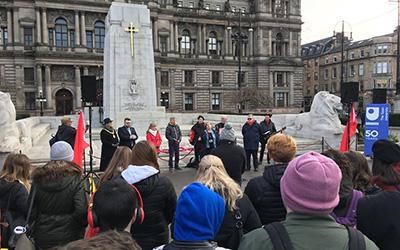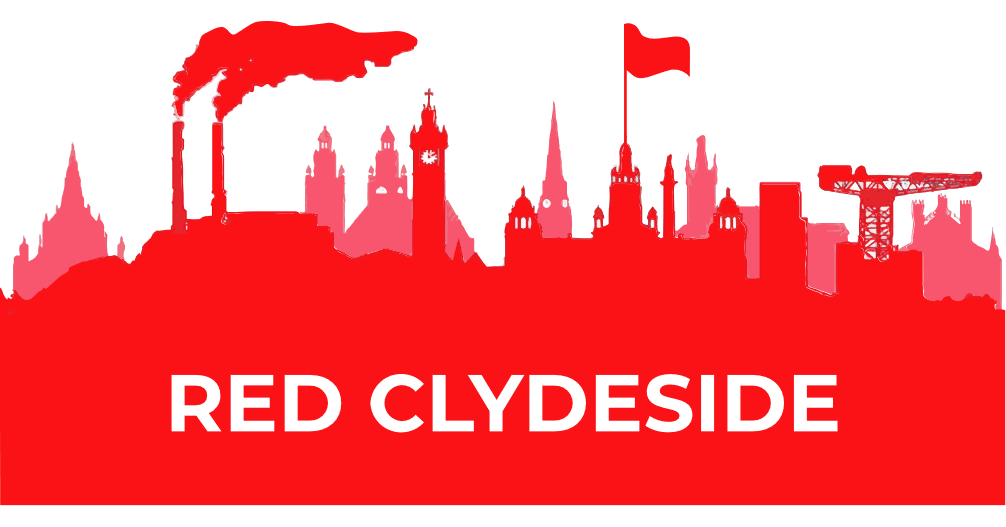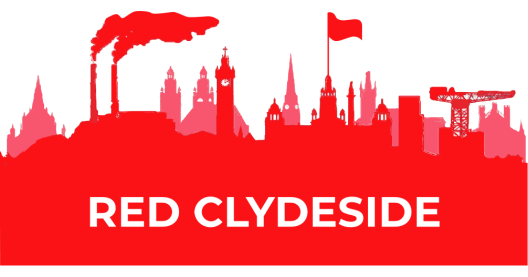 The Open University Learning Event in George Square Glasgow, January 31, 1919, with the Glasgow City Chambers in the background
January 31, 2019 marked the centenary of one of the most infamous episodes of the Red Clydeside era. Alternatively referred to as ‘Bloody Friday’, the ‘Battle of George Square’ saw thousands of striking workers and their families attacked by police as they rallied in support of a struggle for a Forty Hours Working Week. The centenary of this momentous occasion was marked by an Open University learning event on George Square on January 31, 1919, and the Glasgow May Day celebrations on May 6, 2019, also paid homage to the strikers and to the events of 1919.
The Open University Learning Event in George Square Glasgow, January 31, 1919, with the Glasgow City Chambers in the background
January 31, 2019 marked the centenary of one of the most infamous episodes of the Red Clydeside era. Alternatively referred to as ‘Bloody Friday’, the ‘Battle of George Square’ saw thousands of striking workers and their families attacked by police as they rallied in support of a struggle for a Forty Hours Working Week. The centenary of this momentous occasion was marked by an Open University learning event on George Square on January 31, 1919, and the Glasgow May Day celebrations on May 6, 2019, also paid homage to the strikers and to the events of 1919.
The period referred to as Red Clydeside has given rise to numerous publications, including autobiographies and biographies of some of its key protagonists, historical accounts, academic studies, novels, poetry, plays and film output. There are in addition countless online resources that explore the events and consider why it was such a volatile period, and why this came to characterise the Clydeside region, and in particular why was it centered on the city of Glasgow.
This collection, written in mid-2019, takes the events in George Square, January 1919, as a way of reflecting on the wider Red Clydeside period. However, given the rich array of online resources, books and other materials, it is not the intention to travel across well-trodden ground and simply repeat what is already available. Therefore, our main goals here are:
- To highlight the key arguments and controversies around 1919 that continue to be a feature of historical accounts and political debates today, one hundred years and more, later.
- To consider what relevance, if any, Glasgow 1919 (and Red Clydeside more widely) have for our understanding of popular struggles and industrial conflict today, and how has it has shaped Glasgow and indeed wider Scottish and (perhaps also) UK politics.
- To bring together existing online resources in a coherent and structured single article.
In addition to this introductory section, there are 5 other sections in this collection:
Throughout this collection there is reference to existing online sources, books and articles that relate to the Red Clydeside era and to the events in Glasgow, January 31, 1919 in particular. We also utilise speeches from The Open University in Scotland’s Open Learning event held on the centenary of the events in George Square 1919, January 31, 2019.
Gerry Mooney, The Open University in Scotland
This event also featured in some news outlets in Scotland:
STV, ‘Glasgow to mark centenary of the battle of George Square, STV News Online, January 31.
George Square blog: The evolution and history of George Square, Glasgow
The material provided on these pages also links with other materials on OpenLearn:
 This article is part of the Revisiting Red Clydeside: 'Bloody Friday': The Battle of George Square, Glasgow, 1919 collection. All the media-rich articles in this collection provide an introduction to Red Clydeside and consider the developments that led to the Battle of George Square in Glasgow in January 1919, and also reflect on the enduring legacies of this period.
This article is part of the Revisiting Red Clydeside: 'Bloody Friday': The Battle of George Square, Glasgow, 1919 collection. All the media-rich articles in this collection provide an introduction to Red Clydeside and consider the developments that led to the Battle of George Square in Glasgow in January 1919, and also reflect on the enduring legacies of this period.









Rate and Review
Rate this article
Review this article
Log into OpenLearn to leave reviews and join in the conversation.
Article reviews